We have finally managed to get our immediate yard area trimmed and cleared away (what they call in Spanish “cleaned”) and felt that we were ready to plant some fruit trees to begin our finca (farm). Many varieties take years before they fruit, so we wanted to get started as soon as possible. When we first bought the property we had planted a piña mango tree and a corazón tree, but so far we have only been able to find the corazón (we found our heart in Puerto Rico! 😉 ).
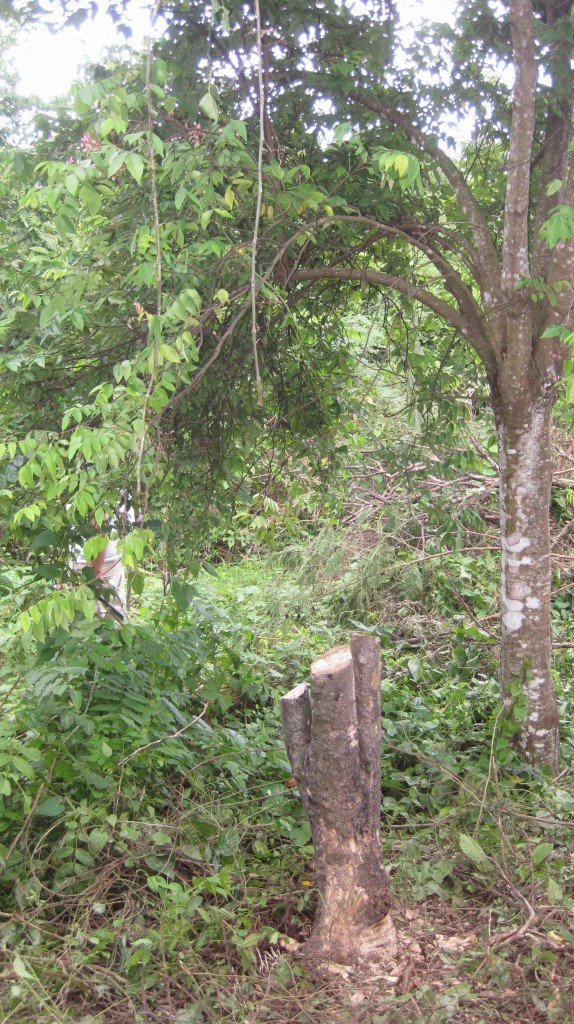
Stump of a dead citrus with the starfruit completely fine (and flowering again!)
We have read that Puerto Rico (among other places) is experiencing some major citrus diseases, such as citrus greening, that are affecting fruit yield and killing off the citrus trees. We found that to be true on our property as well, though we aren’t sure of the cause of death. We had to remove 3 old growth citrus trees that were completely dead.
We could tell they were citrus by the thorns on their deadened branches. It is unfortunate because those trees would have been probably 10-15 feet tall by now and producing like mad. But we do have a few other citrus trees that are still alive, at least for now. We are going to fertilize and prune them and see if there is any hope for them.
We do have some other old growth trees like the huge coconut trees, the carabola (starfruit) and an avocado tree. We even had to get a big tree trimmer in order to get the coconuts down and to trim the palm fronds.
We are not sure what else we have on the property because we don’t know too much about what grows here, but we were determined to find out or know it because we put it there. With about 4 acres of land, we would have to plant a lot before it could ever be filled.
So we talked with some of the local fruit venders and they said they get their plants at a place called Jardines Eneida in Cabo Rojo which is a beautiful little seaside town on the farthest southwest of the island. We looked up the address to the nursery and followed the map directions they had on their website. Big mistake! Their website lists completely different map directions than where they are actually located!
We drove around in circles for half an hour pointing at the spot it SHOULD be but obviously was not. Finally we pulled the truck aside so I could ask for the correct directions in Spanish from two middle aged women who were having a conversation under a large shade tree. They both knew where it was and said we were definitely in the wrong area. After giving us the directions we still felt very turned around and one of the women could tell. She offered to lead us straight to it! How nice is that!?
We followed her to the nursery and I thanked her profusely. We offered to buy her a small plant if she would like, but she refused only saying “a sus ordenes” meaning loosely that she was at our service and happy to help.
At Jardines Eneida we were in our element. We loved looking around at all the different plants–most of which we have no idea what they taste like or look like as full grown trees/plants. The prices were reasonable with most things in the $5 to $8 range for fruit trees. We loaded up a little wagon with nearly 20 different species of plants.
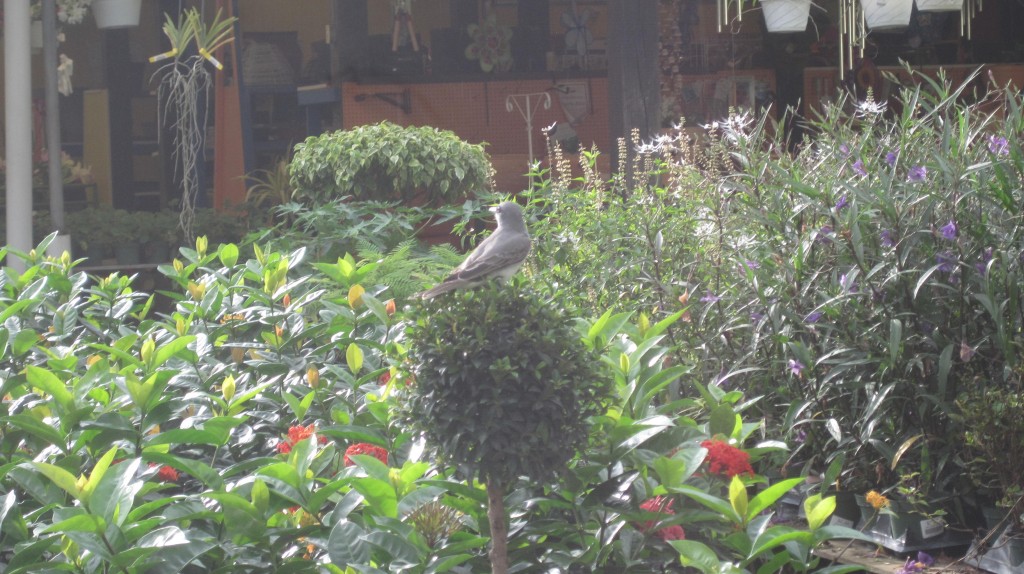
This is a real bird! I thought it was so cute sitting on the topiary
Then it started to rain -hard! We waited under the shelter area for about 45 minutes until it let up. Finally we were able to pay and load up the truck. We laid the plants on their sides so that they wouldn’t get too wind-whipped in the approximately 60 minute drive back.
When we returned we looked at their website again to see if we had just written the directions wrong, but nope, it was on their site that way with the wrong map (right address though). Too bad we hadn’t seen this post by CA2PR beforehand. It seems that Jardines Eneida is a right of passage for anyone looking to grow their own food and plants on the west side of the island!
The best way to actually find Jardines Eneida from the north is to stay on the 100 until the 308 and then turn left and go until you see a little store called The Tropical Corner, turn right on that road which is 103 and follow until you see Jardines Eneida on the right.
Here is a list of all the plants we bought. The total for everything was less than $150 which we thought was reasonable for this many trees/plants:
Cacao Rojo (Red Cocoa/Chocolate tree)
Aguacate Candalaria (avocado)
Pink and red trinitaria/bougainvillea
Canna
Platano (plantain) -We still want bananas but they were out
Guayabana (Soursop)
Naranja agria (sour orange)
Fruta maravillosa (Miracle Fruit)
Philodendrum Monstera
Granada (Pomegranate)
Toronja Red blush (Grapefruit)
Guayaba (Guava)
Carambola (Starfruit)
Café (coffee)
China del país -citrus sinensis -country orange
Mangostán -Mangosteen
Limón del país -country lime
We also have bought from other venders:
Chironja (grapefruit/orange mix)
Jobo (Not sure name in English)
Another cacao/chocolate tree
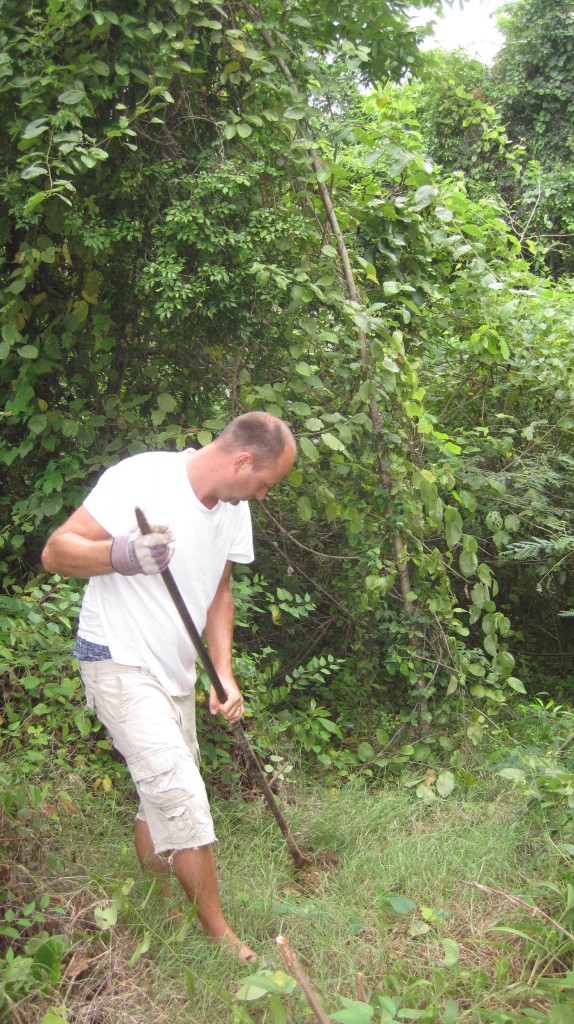
Finding a home for the aguacate
We have started to plant them but it is a lot of work clearing out the lower 1-2 acres and removing the old dead trees and sawing down the termite trees, so it might take us a while! As for the new citrus, we are looking for organic (or less toxic) ways to deal with and prevent these plant diseases. We’ll let you know what we find. So far, we are having so much fun making our own real tropical “Farmville” out here.
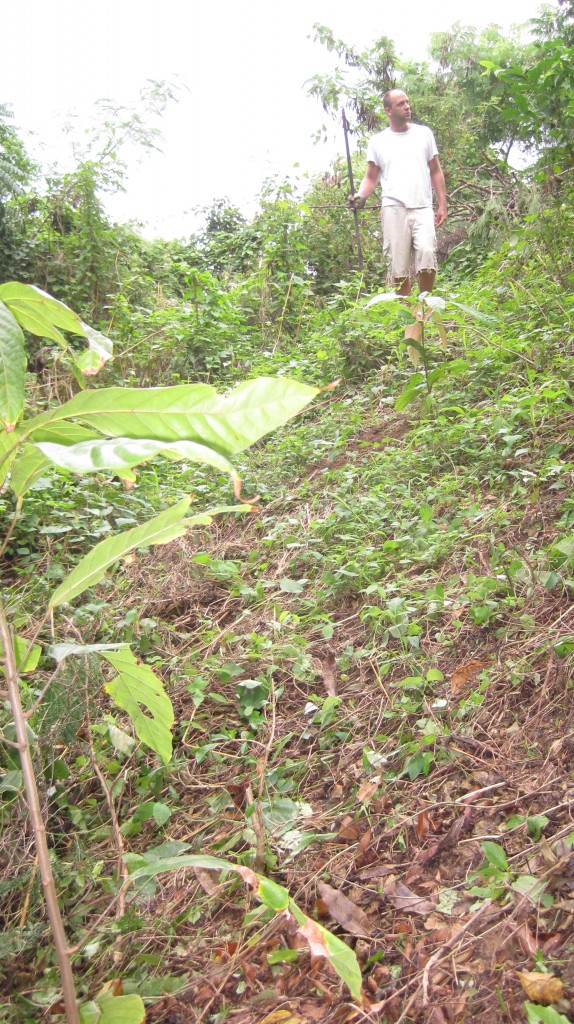
The two planted chocolate trees (immediate left and directly under BK)

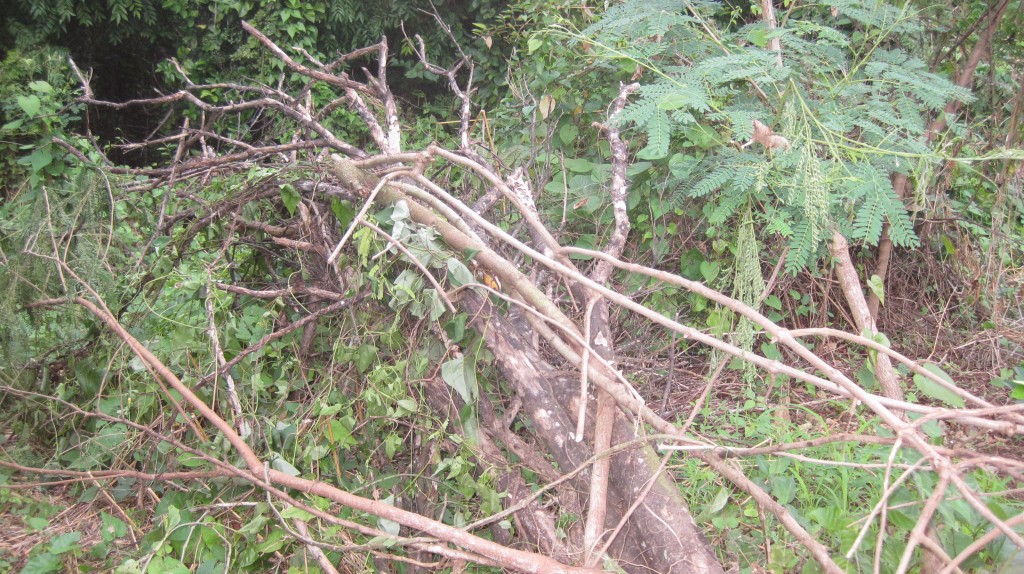
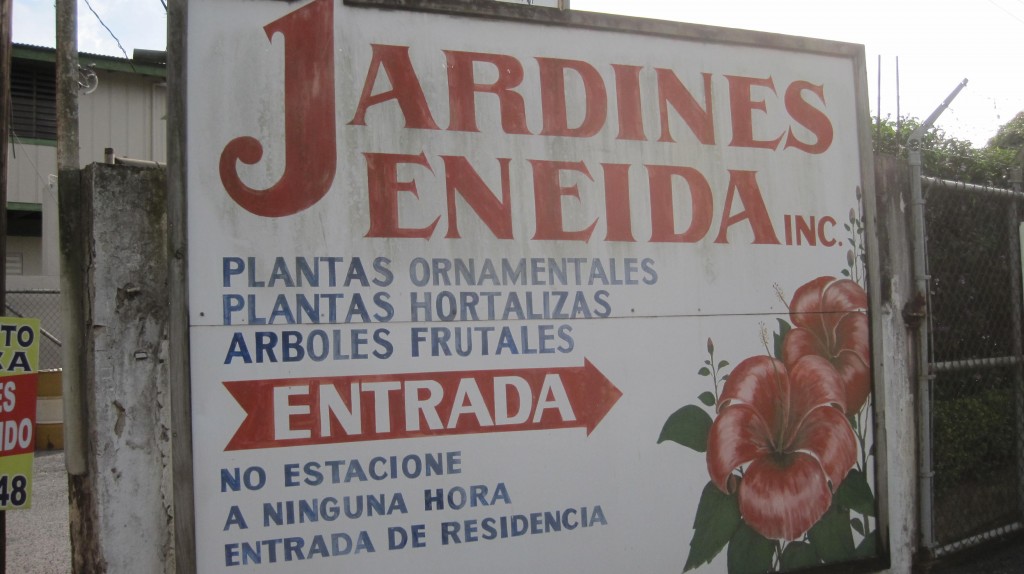
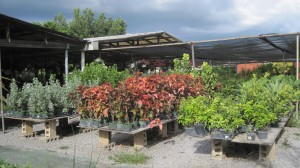
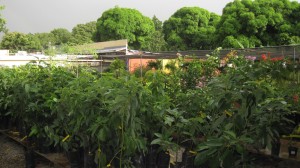
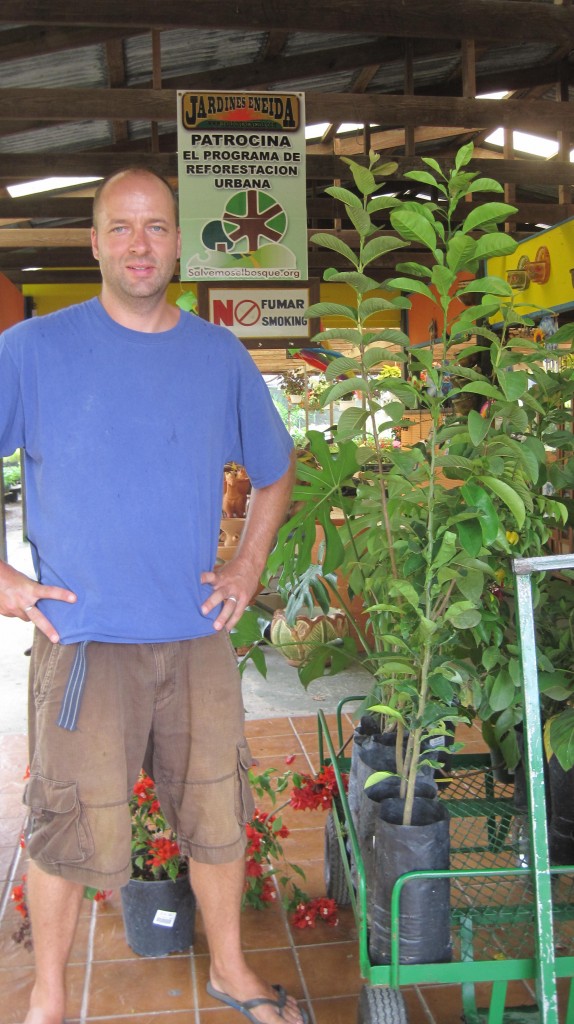
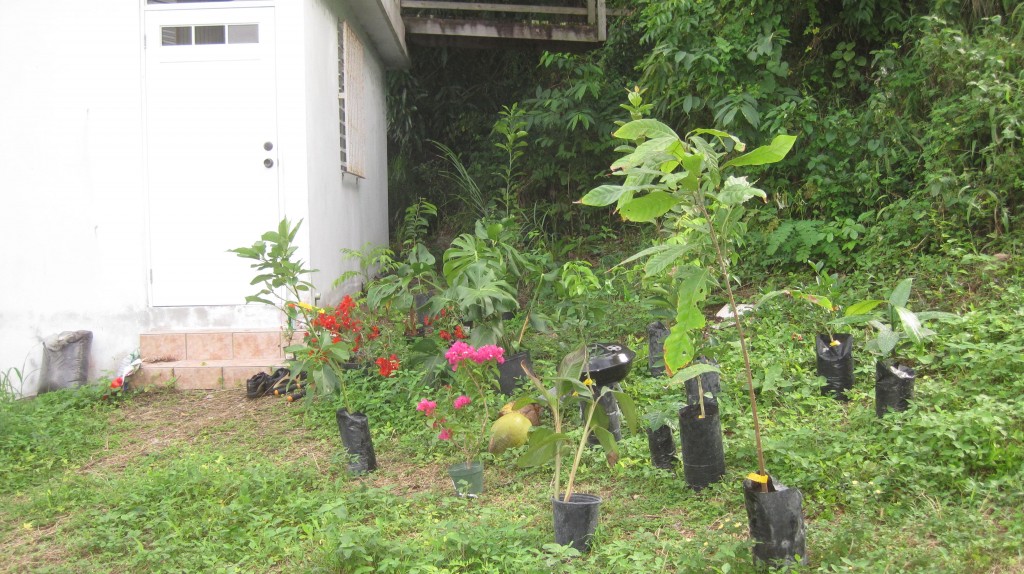
The Jardines Eneida are/is a find!
Have a few suggestions we’ve found work from our landscape biz experience:
Make a plan for the entire 4 acres, including your houses, driveways, any current or planned hardscape, walls, fountains, water sources, pathways, drainage etc. Plan for compatible planting zones (soil acidity, drainage needs, sunlight etc) . Draw the full size of each tree or shrub in the zone on your plan. A vegetable garden will need maximum sunlight and drainage. Avocados and citrus in particular need maximum drainage as well, as these trees get root rot and like to dry out. Avocados like hill side locations for this reason.
Second, condition of soil is important, so if possible find a source of clean high nitrogen manure, preferably chicken. Mix with ground or chopped up leaves, sticks, grass, etc. and begin to compost. Should compost quickly with your heat and rain.
Clean and plant one compatible zone at a time; interplant with compatible shrubs or flowers if you like. Soil preparation is important but you don’t need a huge area of disturbance (unless your site is very rocky and poor, but from your pictures, that doesn’t appear to be a problem!),
We have found that having a complete master plan, quality soil and slow implementation of the plantings works the best and the results will be long lasting.
Hope this helps and you have as much fun as we do in the garden!
love Jardines Eneida! luckily we followed Stefan’s directions when we went a few years back. I’ve bought and re-bought trees there. Watch out, you will find out like the rest of us that is it REALLY EASY to weedwack your new little trees!! We now have orange stakes near them along with white pebbles around the base AND we open up the containers to use as collars BUT it still happens! Luckily the trees are fairly inexpensive. Next stop HAS to be Govardhan Gardens. Wait till you see what Sadhu Govardhan has! I will email him and see if he is around while we are there.
Looks like you two got your work cut out for you. If you ever get up are way we have bananas growing all over in the wild you would just have to dig out the hijos. (sons around the mother plant) My wife’s tío (uncle) is the plantain king of Patillas he has about 50,000 plants that’s where we got ours. We do have a few orange and grapefruit trees but like you said about the citrus diseases last year they didn’t produce much fruit. I know we have a lot of other type fruit trees on the property but I need to do the same thing you’re doing and clear the jungle. HAVE FUN
My dad built a redneck version of that telescopic tool and it works terribly. I would buy him one of those but he would probably reject it out of pride. Whenever I see him working on the yard he is dangling off some contraption that looks like it was designed just to spite OSHA. Its good to see your awesome progress. Just be careful with your fingers when you’re opening those coconuts!
I have to agree with adolfojp OSHA would never make it in PR, but I must say the people are very resilient on figuring ways out to do things with what they have. We used a 30 foot peace of bamboo and ducked taped a serrated knife on the end to get our coconuts down. There actually is a coring tool you can buy to pull the stem out and put a straw in to drink the water. But the machete is used most of the time. That seems like the all-purpose tool of Puerto Rico.
Your article inspired research about some of the plants that you purchased. Learned that chocolate trees need shade, about 70% when young, don’t know about older specimens. Interesting original name for avacado. Of course this is purely cold country research/quest for knowledge so I have no locals to provide actual growing know how. Good luck on your growing adventure, pun intended.
OMG…I want to find a house in Puerto Rico and do this…grow my own trees and vegetables. where and how do I start?